“When public art is done well it inspires a sense of awe and wonder,” says Miranda Lash, curator of contemporary art, The Speed Art Museum.
That’s exactly what The Speed Art Museum had in mind when it installed contemporary Chinese artist Ai Weiwei’s public sculpture, Circle of Animals/Zodiac Heads; Bronze Series at the Elizabeth P. and Frederick K. Cressman Art Park last October. Comprised of twelve oversized bronze animal heads, Circle of Animals/Zodiac Heads; Bronze Series is a monumental work by one of China’s most well-known artists.
“This is not an exaggeration to say that Ai Weiwei is the most well-known living artist,” says Miranda Lash, Curator of Contemporary Art, The Speed Museum. “He represents the ongoing struggle for freedom of expression and dissent against the Chinese government.”
Born and raised in China, Weiwei came of age as an art student in 1990s New York. Some of his most notable pieces include Sunflower Seeds, which consisted of 100 million hand-painted porcelain seeds, and the iconic “Bird’s Nest” design for the Beijing National Stadium for the 2008 Summer Olympics.
As a political activist, Weiwei repeatedly found himself at odds with the Chinese government, which landed him under government surveillance and house arrest for almost a decade.
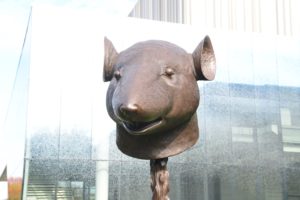

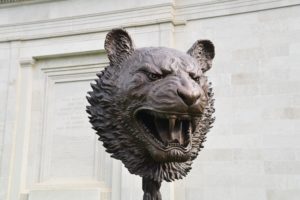
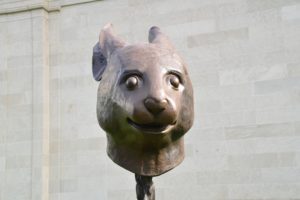
The Year of the Rooster
However, you don’t need to be familiar with Weiwei, says Lash, to enjoy this particular installation since many people already feel a built-in personal connection with the Chinese zodiac. “People are familiar with the Chinese zodiac and identify the animal with the year they were born. People like seeing these animals on such a monumental scale,” she says.
The twelve animals featured in Circle of Animals/Zodiac Heads derive from the Chinese astrological calendar. The 12 bronze zodiac heads (rat, ox, tiger, rabbit, dragon, snake, horse, ram, monkey, rooster, dog, and boar) stand on bronze columns atop marble bases. Each animal head weighs approximately 800 pounds and measures approximately 4 feet high and 3 feet wide. Each head and base together is approximately 10 feet high and weighs nearly 1,000 pounds.
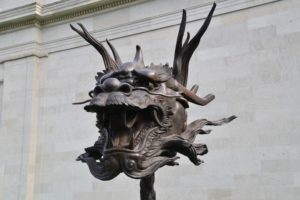

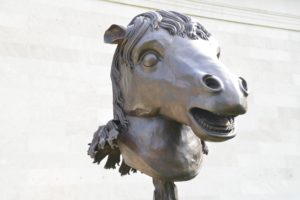
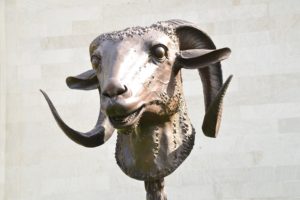
Tying Together Nationalism, Irony
Weiwei’s inspiration for the twelve bronze animal heads came from the traditional Chinese zodiac fountain clock created in the 1700s for the gardens of Yuanming Yuan, an imperial retreat outside of Beijing, China. The Qianlong Emperor commissioned Giuseppe Castiglione, an Italian Jesuit, to create gardens and fountains with a sense of “Western opulence.” In its original design, each of the zodiac animals corresponded to a two-hour period on a 24-hour cycle. In its original design, each animal sprayed water from its mouth during its appointed two-hour period.
In 1860, Yuanming Yuan was destroyed by invading English and French armies during the Second Opium War. Many of its treasures, including its zodiac heads, were looted and sold.
In the late 1980s, five of these heads were auctioned at Sotheby’s and have since been repatriated to China. Two heads appeared in a controversial 2009 auction at Christie’s. The whereabouts of the remaining five heads (the dragon, ram, snake, rooster and dog) remains unknown.
“Conceptually, Circle of Animals/Zodiac Heads evokes a complicated history of cultural exchange, war, looting, and commerce,” says Lash.
Don’t forget the irony of the piece. “He created this artwork based on the theme of nationalism, and Chinese national pride to retrieve these animals,” says Lash, “But it was an Italian design, made by Italians.”
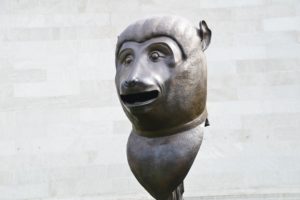
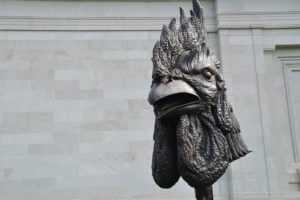

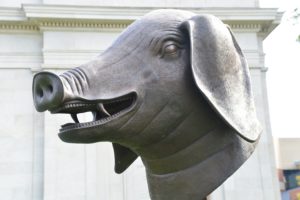
Last Look
Ai Weiwei’s Circle of Animals Zodiac Heads will be on display on the 1927 Building Lawn at the Speed Museum through September 24, 2017.
To commemorate the closing, Ai Weiwei and the Future of Chinese Museums, a Lecture by Professor Jeffrey Johnson will be held on September 17 at 3 p.m. Johnson, director of the School of Architecture at the University of Kentucky School of Design and a principal of SLAB Architecture, will speak about Ai Weiwei’s impact as an activist, artist and architect. The event is free and open to the public.


